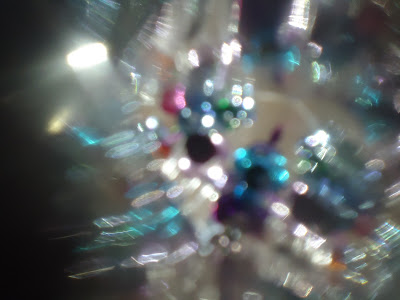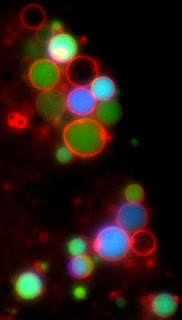 |
| starting to realise why my parents hate me working at home... |
Saturday, 25 February 2012
Wax. Everywhere.
Me and Yasmin thought of burning down a load of candles and trying to melt them into each other would create some good imagery and shapes for our concepts of cells and growth. However, when I actually tested this theory out it created something completely different...I left the room for half an hour and returned to this mess all over my dinig room table and the surrounding floor...
Sunday, 19 February 2012
Wellcome Collection
Wednesday, 15 February 2012
Kaleidoscope
Kaleidoscope yaaaay - becoming a child again all in the name of textiles! I thought using a kaleidoscope would be a fun and interesting way of creating cell like images; the collections of colours and shapes and the multiple reflections. That and it was a good excuse not to draw (no like drawing) and to make a toy...
Microscope
Soooo thanks to Yasmin having a microscope at home we decided to be scientists for an afternoon and see what images we can get. Using mostly our lunches to view through the microscope we got some amazzzing images and truely stunning colours from tiny ordinary food items. Red grape skin in particular gave an incredible colour effect.
 |
| grape flesh |
 |
| red grape skin |
 |
| tomato seed |
 |
| leaf? |
 |
| science Niamh! |
 |
| our subjects |
 |
| casual outdoor science |
Science Museum
Me and Yasmin took a trip to the Science Museum to gather some research based on cells. The Wellcome Museum of the History of Medicine and The Science and Art of Medicine sections were particulary useful. We also had a massive giggle along the way - it's looking like the start of something beautiful!
 |
| Interactive spots |
 |
| we found this babe in the History of Medicine room |
Transition
For this new fashion project we have been given the theme of Transition. We are to work in pairs or threes and develop a project with either the same concept or concepts that could come together for a final fashion outcome. The outcome is to be one fashion ensemble, be it made up of several garments or just one, but each group members work must be separate.
I'm working with my good friend Yasmin, I think we will work well together as we have similar work ethics yet work very differently - me being a more process led person whilst Yasmin works well with a structured concept.
We have settled on a concept based around cells and growth - lots of pretty patterns and colours!
I'm working with my good friend Yasmin, I think we will work well together as we have similar work ethics yet work very differently - me being a more process led person whilst Yasmin works well with a structured concept.
We have settled on a concept based around cells and growth - lots of pretty patterns and colours!
Monday, 6 February 2012
Blythe House Visit
Towards the end of last term we visited the V&A textiles archives at Blythe House in Kensington Olympia, I thought this would be a boring trip where we wouldn't actually get to see anything because they would be too busy telling us about the place and all its rules (and there were many), however I was very pleasantly surprised and found the whole day very enjoyable. After a talk with those in charge of the archives about their work and about the archives themselves, what is available to us and how to access it, we looked at the textiles related pieces they had taken out for us to view. The pieces ranged from fabric samples, to magazines from the 1950s to beautiful artwork to inspire prints. A lot of the work was from the 1950s which I loved as the prints and fabric were just so sweet and delicate, I found it all inspiring. Its amazing to know that we have these incredible resources available to us, and for us to be able to physically see and feel them makes so much difference instead of staring at them through a glass cabinet.
Grayson Perry & The Power Of Making
It was very interesting to see the vast differences in the two exhibitions; one being a fine artist using craft processes, and the other a collection of the work of craftspeople. Grayson Perry has his own personal take on these different craft forms to create this body of work, it is more of a homage to craftmanship - a celebration of craft and the artist himself paying respect to those who have crafted the pieces. Whereas, the power of making, although still a celebration of craft and its makers, was exhibiting in a very different way. It felt more like a presentation of the best and brightest craftspeople and designers, placing a wide variety of work by a number of artists side by side - each one an individual, brought together in this exhibition to celebrate the beauty and creativity in modern craft, whilst the Tomb of the Unknown Craftsman was more of a collective.
Although Perry used craft processes, the pieces still remained fine art pieces; a collection of weird and wonderful objects each raising questions of their own. Craftsmanship is an individual using their hands and deep thought processes to create something beautiful and unique; using great and expert skill to perfect their craft. Both the Power of Making and the Tomb of the Unknown Craftsman show beautiful and exciting work - both are full of surprises as you can't guess what you'll find next; from a Hello Kitty hand towel to a lifesize crochetdermy bear.
The Grayson Perry exhibition celebrates craft throughout the years; as some of the work dates back hundreds of years. Whereas the Power of Making celebrates where craft is today - a body of work using new and traditional technniques; disposing of the idea that craft is something oldfashioned, this exhibition proved craftmanship is exciting and creative and doesn't neccessarily rely on the past.
Although Perry used craft processes, the pieces still remained fine art pieces; a collection of weird and wonderful objects each raising questions of their own. Craftsmanship is an individual using their hands and deep thought processes to create something beautiful and unique; using great and expert skill to perfect their craft. Both the Power of Making and the Tomb of the Unknown Craftsman show beautiful and exciting work - both are full of surprises as you can't guess what you'll find next; from a Hello Kitty hand towel to a lifesize crochetdermy bear.
The Grayson Perry exhibition celebrates craft throughout the years; as some of the work dates back hundreds of years. Whereas the Power of Making celebrates where craft is today - a body of work using new and traditional technniques; disposing of the idea that craft is something oldfashioned, this exhibition proved craftmanship is exciting and creative and doesn't neccessarily rely on the past.
 |
| my favourite piece from the two exhibitions |
Sunday, 5 February 2012
Reflective Statement
During the first unit of the term I feel I basically learnt how things work on a degree course. I soon realised after starting that BA level is a lot more laid back in terms of how you should work and in what ways you should be doing things, and how they should look, which was a big change from foundation level, where everyone had to work in a particular way. I really liked this new style of working were you could work in any way you wanted, and meant that everyone’s work looked really different. The rough guide project was the perfect transition into this new world, as it allowed us to go out and work in an area with new people, and work in any way you wanted. Through this project I learnt to just have more confidence in my work and my abilities instead of constantly fearing that I was behind everyone else on this course and comparing myself to others. I didn’t have too many issues in regards to the blog, as I had used blogs before as a sort of “reflective journal” where I could write about my work simply as I saw it and reflect on it. But, I’m no natural blog writer, I often find it difficult to reflect on things other than my work, and often find myself writing my train of thought, and usually looks like a conversation I’m having with myself. I do like looking back through the blog to see how I’ve progressed, and I think this probably the best way to reflect on my work and evaluate how I have done as it is an honest look at my work. To improve the blog I need to blog more often, stop looking like I’m talking to myself, and develop the style in which I write. And I should probably stop talking about myself as much; that might make it more interesting for other people.
Knit Technical Block
Knit was my last technical block, and the one I was most looking forward to. I really love knit and my whole final project for my foundation was based on hand knitting, so I couldn't wait to get into knit to see what I could do. However, for the first while in knot I found it very frustrating (as did many others) as it is quite a difficult process to get into and takes a lot of trial and error to get it right. It's also a very broad area, as there are literally hundreds of techniques possible and when you only have a two week time frame its difficult to try everything and get everything practiced enough for it to look good. However, as the block progressed I found myself gaining more confidence in my work and my ability to use the knitting machine, and found myself using the same few techniques to develop my work instead of trying to do everything when not all the techniques actually related to my work. My preferred techniques were cables, using small patterned punch cards, hooking the knitting back up onto the needles, and a combination of lace holes and ladders. By the end I really got into knit, and really enjoyed the process, as it is much more fast paced than weave which I often found tedious, however there was a lot more room for error for mistakes in knit which was quite disheartening. There was also not much in terms of tutor feedback, which left me feeling a bit lost as to how I was doing.


Weave Technical Block
Weave happened to be the technical block I was most dubious about, I was too sure if I'd enjoy the longer process, and the fact that it's a lot harder to picture the final outcome then say print is. Overall I did enjoy the block, I was really happy with the work I produced and also enjoyed the off loom work, I found that the off loom work was great for helping me plan and get inspiration for my on loom work. I feel that the other technical blocks should have had some equivalent work, as it was useful and aided the design process. However, I found the process of weaving quite long but thought it was quite relaxing as I found myself drifting off whilst on the loom. I also struggled with trying to make my work look a bit different and interesting, I'm nnot sure whether this was because of the long process and not being able to take the weave off the loom until the last day, or because there was not a great deal of tutor feedback during the block and we were left pretty much to our own devices for the two weeks.


Subscribe to:
Posts (Atom)









































